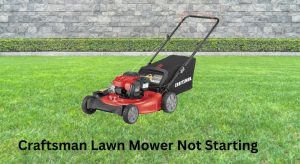If your Craftsman lawn mower starts and then sputters out, you’re not alone. A Craftsman lawn mower not staying running is usually due to fuel issues, clogged carburetors, or simple maintenance items. Quick fix: check the fuel cap vent and air filter first. Loosen the fuel cap and try running the mower—if it stays on, the cap vent is blocked. Then inspect or replace the air filter to ensure proper airflow.
In this guide, you’ll get step-by-step solutions to diagnose and fix the problem for good. We’ll cover the most common causes, quick fixes, deeper repairs like carburetor cleaning, and prevention tips to keep your mower dependable all season long.
Common Causes of a Craftsman Lawn Mower Not Staying Running
- Stale or ethanol-heavy fuel causing poor combustion
- Clogged carburetor jets or stuck float
- Dirty or oil-saturated air filter choking airflow
- Blocked fuel cap vent creating a vacuum in the tank
- Dirty or failing spark plug
- Contaminated fuel lines or clogged fuel filter
- Faulty or stuck choke linkage
- Water in fuel from condensation
- Governor or throttle cable misadjustment
- Low engine compression (worn rings/valves—less common)
Stale Fuel or Water in Fuel
Gas older than 30–60 days can cause hard starts and stalling. Ethanol-blended fuel absorbs moisture and gums up carburetors.
Clogged Carburetor
Dried fuel residue blocks jets and passages, causing the engine to run briefly on primer fuel and then die.
Dirty Air Filter
An overly dirty foam or paper filter restricts airflow, leading to rich running and stalling.
Blocked Fuel Cap Vent
A blocked vent creates vacuum lock. The engine starves for fuel and dies after 30–60 seconds.
Spark Plug Issues
Fouled, cracked, or improperly gapped plugs can misfire under load and stall.
Fuel Line/Filter Blockage
Cracked, kinked, or gummed fuel lines and filters reduce fuel flow.
Choke/Throttle Problems
Choke stuck closed or cable out of adjustment causes rich mix and shut-off once warm.
Low Compression
Rare on newer units but possible on older mowers; causes weak power and stalling.
How to Fix a Craftsman Lawn Mower That Won’t Stay Running

Work from the quickest checks to the more involved fixes. Total time can range from 10 minutes to 1.5 hours depending on the issue.
Method 1: Quick Checks (Fuel Cap, Air Filter, Plug) — 10–20 minutes
Diagnosing the Issue
- Does it start and die after 30–60 seconds? Suspect fuel cap vent or fuel flow.
- Dies immediately after the primer fuel burns off? Suspect carburetor clog.
- Surges or hunts? Suspect carb jet or governor/throttle linkage.
Fix Steps
1) Test the fuel cap vent:
– Loosen the gas cap slightly and start the mower.
– If it runs longer than before, the cap vent is clogged. Replace the cap.
2) Inspect the air filter:
– Remove the filter cover. Check if foam is oil-soaked or paper element is dark/plugged.
– Foam filter: wash in warm soapy water, rinse, dry completely, then lightly oil and squeeze out excess. Paper filter: tap out debris or replace.
– Reinstall and test.
3) Check the spark plug:
– Remove plug (usually 13/16″ or 5/8″ socket).
– Inspect tip: dry tan/gray is good; wet black/oily indicates rich mix; white indicates lean.
– Clean with a wire brush or replace if worn. Gap to 0.028–0.030 in (0.7–0.76 mm) unless your model specifies otherwise.
– Reinstall snugly and test.
Testing
- Run the mower for 3–5 minutes. If it still stalls, proceed to fuel and carburetor checks.
Method 2: Fuel System Refresh — 20–40 minutes
Diagnosing the Issue
- Old fuel or water contamination often causes start-then-die symptoms and rough running.
Fix Steps
1) Drain old fuel:
– Use a siphon pump to remove fuel from the tank into an approved container.
– Dispose of old fuel properly at a recycling center.
2) Inspect fuel line and filter:
– Look for cracks, kinks, or soft/spongy sections.
– If your Craftsman has an inline filter (common on some Briggs & Stratton or Kohler engines), replace it. Arrow should point toward the carb.
– If there’s a tank screen, ensure it’s clear.
3) Add fresh fuel:
– Use fresh, ethanol-free fuel if possible (E0). If using E10, add a quality fuel stabilizer.
– Mix in a carburetor cleaner additive per label directions.
4) Prime and start:
– Prime per your model (usually 3–5 pushes).
– Start and run for several minutes to pull fresh fuel through.
Testing
- If the mower still dies after the primer burns off, the carburetor likely needs cleaning.
Method 3: Clean the Carburetor (Float Bowl/Jet Service) — 30–60 minutes
Important: Work in a well-ventilated area. Turn fuel valve off (if equipped) and disconnect the spark plug wire before servicing.
Diagnosing the Issue
- Engine starts, runs on primer, then dies.
- Surging or hunting at idle/part throttle.
- Fuel smell and drips from carb bowl = sticking float/needle.
Fix Steps
1) Access the carburetor:
– Remove the air filter housing and any covers.
– Clamp the fuel line or turn the fuel valve off.
2) Remove the float bowl:
– Place a rag under the carb.
– Unscrew the bowl nut (often a 1/2″ or 10 mm). On many Briggs & Stratton carbs, the bowl nut doubles as the main jet.
3) Clean the main jet and passages:
– Inspect the bowl nut/jet. You’ll see tiny holes—clear them with a small wire or carb jet file. Do not enlarge holes.
– Spray carb cleaner through all passages until it flows clean.
– Clean the bowl and the float area.
4) Inspect float and needle:
– Ensure the float moves freely and sits level when inverted; replace the needle if the tip is grooved or sticky.
– Replace the bowl gasket if it’s brittle or swollen.
5) Reassemble:
– Reinstall bowl and jet/nut. Do not overtighten—snug plus 1/8 turn.
– Reattach fuel line and airbox.
6) Optional deep clean:
– If performance is still poor, remove the carb completely and soak in carb cleaner; blow through passages with compressed air.
– Replace gaskets and O-rings with a carb rebuild kit for your engine model (check engine model numbers like Briggs 6.75 ft-lbs 190cc, Kohler XT series, Honda GCV series used on some Craftsman mowers).
Testing
- Start the engine and let it warm for 3–5 minutes. It should idle smoothly without stalling. If it surges, adjust the mixture screw (if present) per manufacturer guidance; many newer carbs are fixed-jet.
Method 4: Choke, Throttle, and Governor Checks — 15–30 minutes
Diagnosing the Issue
- Engine runs only with partial choke, then dies when choke is off.
- RPM hunts up and down at steady throttle.
Fix Steps
1) Choke linkage:
– Move the control lever while watching the choke plate. It should fully close for start and fully open when running.
– Lubricate pivot points lightly; correct any bent linkages.
2) Throttle cable:
– Verify the cable moves freely and returns to idle. Adjust the cable clamp if the lever doesn’t reach full range.
3) Governor spring:
– Inspect the governor spring and linkage for stretch, damage, or misrouting.
– Replace any weakened springs and verify correct holes per engine manual.
Testing
- Run at full throttle under no load. If smooth, engage the blade and cut a test strip to confirm stability.
Method 5: Spark and Ignition Checks — 10–25 minutes
Diagnosing the Issue
- Random stalling after warm-up, weak spark, or no restart when hot.
Fix Steps
1) Spark test:
– Use an inline spark tester. Look for a bright, consistent spark while cranking.
– If weak or intermittent, replace the spark plug first.
2) Ignition coil/armature air gap:
– If problems persist, check coil gap to flywheel (typically 0.010–0.014 in). Use a business card as a spacer if you don’t have a gauge.
– Replace a failing coil if there’s no spark when hot.
Testing
- Run for 10+ minutes at operating temperature. Confirm steady performance.
Method 6: Compression and Mechanical Health — 15–30 minutes
Diagnosing the Issue
- Hard starting, low power, and stalling under load after all fuel/spark checks.
Fix Steps
1) Compression test:
– Remove spark plug, install a compression gauge, throttle wide open, crank 4–6 pulls.
– Healthy small engines typically show 70–120 psi; check your engine spec. Low readings suggest valve or ring wear.
2) Valve clearance (OHV engines):
– If you are comfortable, check and adjust valve lash per spec (commonly 0.004–0.006 in intake/exhaust) when cold.
– Incorrect lash can cause loss of power and stalling.
Testing
- After adjustments, restart and test under load.
How to Prevent Future Stalling on Craftsman Lawn Mowers
- Use fresh fuel; add stabilizer if storing >30 days.
- Prefer ethanol-free gasoline (E0) or premium with stabilizer.
- Run the engine monthly during the season to keep fuel fresh in the carb.
- Replace or clean the air filter every 25 hours or once per season.
- Change oil every 25–50 hours or annually.
- Replace the spark plug every season or 100 hours.
- Drain fuel or run dry before off-season storage.
- Keep the cooling fins and flywheel screen clean to prevent overheating.
- Store the mower in a dry, covered space to reduce condensation in the tank.
Pro Tips
- Prime count matters: Too much priming floods the engine; too little starves it.
- Bowl nut is a jet: On many Briggs carbs, cleaning the bowl nut’s tiny holes solves 80% of “starts then dies” complaints.
- Check for vacuum lock fast: If loosening the fuel cap fixes the stall, replace the cap—don’t drill it.
- Foam filters need oil: Lightly oil after washing; a dry foam filter lets fine dust into the carb and cylinder.
- Keep a rebuild kit handy: A $10–$20 carb kit saves weekend downtime.
- Label linkages during disassembly: Snap photos so reassembly is foolproof.
- Avoid starter fluid: For diagnostics, use carb cleaner sparingly; ether can wash cylinder lubrication.
When to Call a Professional
- You’ve cleaned/rebuilt the carb and the mower still stalls.
- There’s fuel leaking from the carburetor (stuck float needle, seat damage).
- Compression is low or you suspect valve timing issues.
- Ignition problems persist when hot, even after plug/coil replacement.
- Engine surges wildly despite linkage checks (possible governor internal issue).
What to look for:
– Small engine certification or strong local reputation.
– Clear labor rates and parts policy.
– Warranty on repairs (30–90 days typical).
Typical costs:
– Carb clean/rebuild: $60–$120
– New carburetor: $40–$100 part + labor
– Ignition coil: $30–$70 part + labor
– Full tune-up (plug, filter, oil, blade sharpen): $80–$150
Warranty considerations:
– If your Craftsman mower is under warranty, avoid disassembly beyond basic maintenance to keep coverage intact. Check your model’s terms.
FAQ
Q: My Craftsman mower starts and dies in 10 seconds. What’s the first thing to check?
A: Loosen the fuel cap to test for a blocked vent, then check the air filter. If it only runs on primer, the carb bowl jet is likely clogged—clean the bowl nut and jets.
Q: What fuel should I use to prevent stalling?
A: Use fresh gasoline, preferably ethanol-free (E0). If using E10, add stabilizer and buy only what you’ll use within 30 days.
Q: How do I know if the carburetor is the issue?
A: If the engine starts with primer or choke but dies when transitioning to normal running, the carb’s main jet or passages are clogged. Surging is another common sign.
Q: Can a bad spark plug cause stalling after warm-up?
A: Yes. A fouled or heat-soaked plug can misfire under load. Replace and gap correctly before chasing deeper issues.
Q: My mower only runs with the choke on. Why?
A: That indicates a lean condition—most often a clogged main jet, intake air leak, or partially blocked fuel supply.
Q: Should I clean or replace the air filter?
A: Foam filters can be washed and re-oiled; paper elements should be replaced when dirty. Many owners replace both yearly for reliability.
Q: Is it safe to clean the carb without removing it?
A: Yes, you can remove the bowl and clean the main jet/bowl nut in place. For heavy varnish, a full removal and soak is more effective.
Q: How often should I service the mower to avoid this problem?
A: Do a basic tune each season: new plug, fresh filter(s), oil change, and fuel system refresh. Mid-season, knock dust out of the filter and keep the deck clean.
Alternative Solutions
If repeated carb issues persist due to ethanol fuel or storage habits, consider these options:
| Solution | Pros | Cons | Best For |
|---|---|---|---|
| Ethanol-free canned fuel | Long shelf life, cleaner burn | Costly per gallon | Occasional users, storage periods |
| New replacement carburetor | Quick, reliable fix | More expensive than cleaning | Severely gummed or warped carbs |
| Inline fuel shutoff valve | Prevents bowl varnish during storage | Requires minor install | Seasonal storage and transport |
| Fuel filter upgrade | Better debris protection | May require routing space | Dusty environments |
Get Your Craftsman Lawn Mower Working Again
By following this step-by-step guide, you now have multiple ways to fix a Craftsman lawn mower not staying running:
– Quick checks: fuel cap vent, air filter, spark plug
– Fuel system refresh with fresh gas and stabilizer
– Carburetor cleaning and jet service
– Choke/throttle linkage, governor, and ignition checks
– Compression and valve adjustments if needed
Start with the simple fixes and work your way down—most mowers are back to normal after a fresh filter and carb jet cleaning. Don’t let a stalling engine derail your yard work. Try these methods today and keep your Craftsman running strong all season.
Have you tried one of these fixes? Share what worked for your specific Craftsman model in the comments to help other readers. Found this helpful? Bookmark it for your next tune-up and never deal with a Craftsman lawn mower not staying running again.




